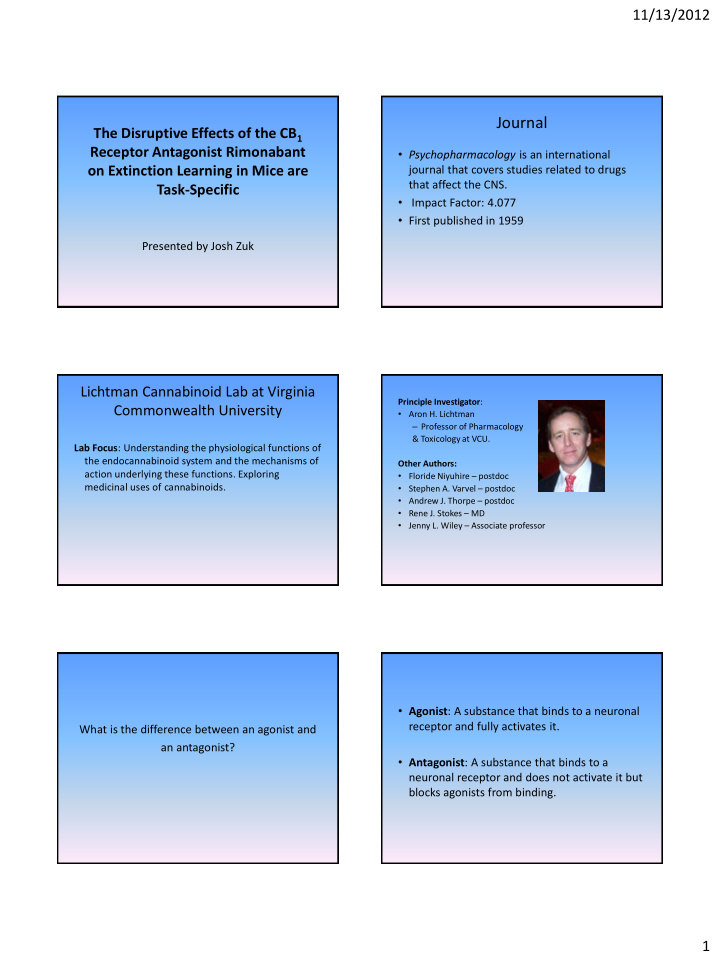



11/13/2012 Journal The Disruptive Effects of the CB 1 Receptor Antagonist Rimonabant • Psychopharmacology is an international on Extinction Learning in Mice are journal that covers studies related to drugs that affect the CNS. Task-Specific • Impact Factor: 4.077 • First published in 1959 Presented by Josh Zuk Lichtman Cannabinoid Lab at Virginia Principle Investigator : Commonwealth University • Aron H. Lichtman – Professor of Pharmacology & Toxicology at VCU. Lab Focus : Understanding the physiological functions of the endocannabinoid system and the mechanisms of Other Authors: action underlying these functions. Exploring • Floride Niyuhire – postdoc medicinal uses of cannabinoids. • Stephen A. Varvel – postdoc • Andrew J. Thorpe – postdoc • Rene J. Stokes – MD • Jenny L. Wiley – Associate professor • Agonist : A substance that binds to a neuronal receptor and fully activates it. What is the difference between an agonist and an antagonist? • Antagonist : A substance that binds to a neuronal receptor and does not activate it but blocks agonists from binding. 1
11/13/2012 Two major types of cannabinoid receptors • CB1 – Mediates psychoactive effects of cannabinoids • CB2 – Found in immune tissues – Found in brain after stroke or inflammatory disease – CB2 agonists can help protect from stroke and neuropathic pain Endocannabinoids What normally binds to CB1 receptors? Endocannabinoid pathway is involved Distribution of cannabinoid binding sites in rat brain in LTP and LTD • Long-Term Potentiation : – Strengthening of synapses – Occurs when two adjacent neurons fire simultaneously – One of the major mechanisms underlying learning and memory • Long-Term Depression : – Weakening of synapses – Occurs after persistent weak synaptic stimulation 2
11/13/2012 Endocannabinoid pathway is involved Long-Term Potentiation in LTP and LTD • LTP is inhibited by CB1 agonists • LTP is enhanced in CB1 KO mice • CB1 agonists enhance LTD Endocannabinoids Retrograde signaling • Anandamide and 2-AG are retrograde messengers. • Synthesized postsynaptically and act presynaptically. Drugs that affect CB1 receptors Methods THC • Conditioned Freezing Test • Passive Avoidance Task • Appetitively Motivated Operant Conditioning Task • Assessment of Locomotor Activity Rimonabant 3
11/13/2012 Conditioned Freezing Test Passive Avoidance Task Appetitively Motivated Operant Assessment of Locomotor Activity Conditioning Task • 2 levers • Traveled distance, speed, and time spent immobile were measured • 1 lever gives sweetened milk when pressed • Mice trained to press lever and receive food reward • Reward was removed and the number of lever presses was recorded Results Figure 1 How did the behavior of rimonabant treated mice differ from the vehicle treated mice in the conditioned freezing test, the passive avoidance task, and the operant conditioning task? 4
11/13/2012 Figure 3 Figure 2 Conclusions • Endocannibinoid system plays an important role in extinction of aversively motivated behaviors • This system does not appear to be involved in extinction of appetitively motivated behaviors Implications • Researchers are currently studying CB1 agonists as a potential treatment for PTSD • Rimonabant was used as a diet pill because of its ability to decrease appetite. It was taken off the market because it frequently led to severe depression and suicidal thoughts. – Possibly due to inability to forget negative memories? 5
Recommend
More recommend